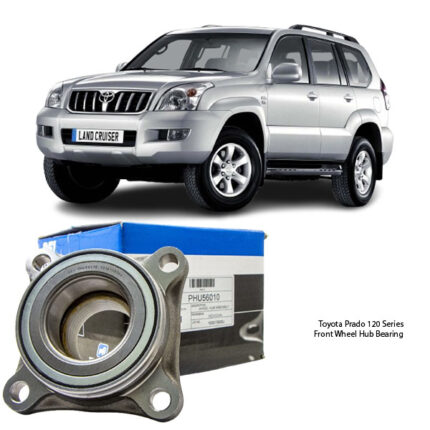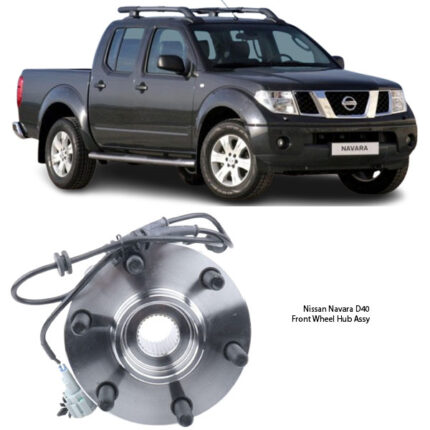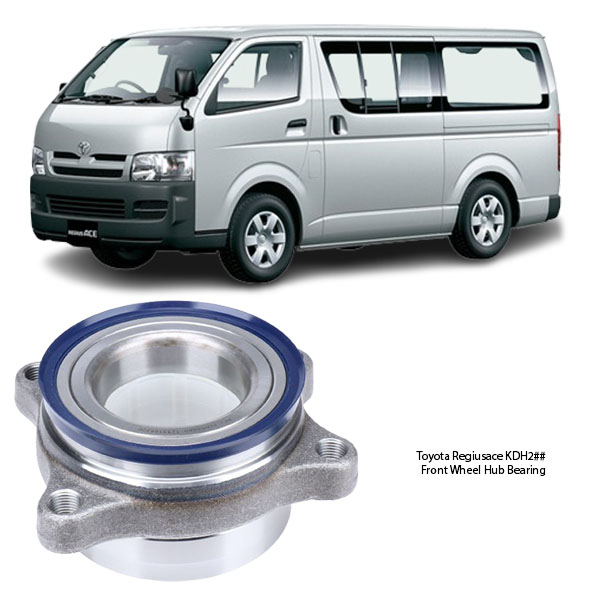-16%
Get Toyota Regiusace KDH2## PFI Front Wheel Hub Bearing PHU56000 in Kenya
The front wheel hub bearing is a crucial component of a vehicle’s suspension and drivetrain system, playing a vital role in ensuring smooth wheel rotation, proper load distribution, and vehicle stability. This detailed guide will explore the function, types, benefits, signs of failure, and maintenance of front wheel hub bearings.
1. What Is a Front Wheel Hub Bearing?
A front wheel hub bearing is a pre-assembled unit containing bearings, a hub, and in modern vehicles, sensors for ABS (Anti-lock Braking System) and traction control. It allows the front wheels to rotate smoothly with minimal friction while supporting the vehicle’s weight and maintaining wheel alignment.
The hub bearing assembly is mounted between the wheel and the axle, with the inner race attached to the axle and the outer race connected to the wheel hub. The assembly enables free rotation while carrying the load of the vehicle.
2. Functions of a Front Wheel Hub Bearing
The primary functions of a front wheel hub bearing include:
a. Supporting Rotational Motion
The bearing enables the front wheels to spin freely and efficiently while maintaining minimal friction. This ensures a smooth and stable ride.
b. Load Distribution
It bears the vehicle’s weight and absorbs forces from acceleration, braking, and cornering, distributing these forces evenly across the suspension system.
c. Reducing Friction
With lubricated rolling elements inside, the hub bearing reduces friction between moving parts, preventing excessive heat buildup and wear.
d. Enhancing Steering Stability
The hub bearing contributes to precise steering control, ensuring the wheels maintain proper alignment and reducing vibrations.
e. Integrating with ABS and Traction Control
Many modern hub bearings come with built-in wheel speed sensors that provide data to the ABS and traction control system, helping prevent wheel lock-up and improving grip.
3. Types of Front Wheel Hub Bearings
There are different types of front wheel hub bearings, classified based on design and function:
a. Ball Bearings
- Comprise steel balls inside a raceway.
- Suitable for lighter vehicles.
- Offer low friction and high-speed capability.
b. Tapered Roller Bearings
- Use cone-shaped rollers to handle both radial and axial forces.
- Common in heavy-duty vehicles and trucks.
- Provide superior load-bearing capacity.
c. Sealed Hub Bearings
- Pre-assembled and pre-lubricated units that don’t require maintenance.
- Often include ABS sensors.
- Offer better protection against contaminants like dirt and moisture.
d. Non-Sealed (Serviceable) Bearings
- Require periodic lubrication and maintenance.
- Used in older vehicle models.
- Offer a longer lifespan if properly serviced.
4. Benefits of a High-Quality Front Wheel Hub Bearing
a. Improved Ride Comfort
A properly functioning wheel hub bearing minimizes vibrations and ensures a smooth ride.
b. Enhanced Vehicle Safety
A worn-out hub bearing can lead to wheel instability or even detachment. A high-quality bearing ensures safe operation.
c. Better Fuel Efficiency
Lower rolling resistance means the engine doesn’t have to work as hard, improving fuel economy.
d. Extended Tire Life
A faulty bearing causes uneven tire wear. A good hub bearing ensures even tire contact with the road.
e. Reduced Maintenance Costs
Sealed hub bearings require no servicing and last longer, reducing overall vehicle maintenance expenses.
f. Optimal ABS & Traction Performance
Hub bearings with integrated ABS sensors provide accurate wheel speed data, improving braking performance and traction in slippery conditions.
5. Common Signs of a Failing Front Wheel Hub Bearing
Recognizing early symptoms of a failing hub bearing can prevent costly repairs and potential safety hazards.
a. Unusual Noises
- A humming, growling, or grinding noise that increases with speed often indicates worn-out bearings.
- Clicking or popping sounds during turns may point to internal bearing damage.
b. Excessive Wheel Play
- A loose or wobbly wheel when shaken indicates bearing wear.
- This can cause steering instability.
c. Uneven Tire Wear
- Irregular tire wear patterns can be a sign of a faulty hub bearing affecting alignment.
d. Vibrations in the Steering Wheel
- A damaged bearing may cause vibrations or a shaky steering wheel.
e. ABS Warning Light
- If the bearing has an integrated ABS sensor, a malfunction may trigger the ABS light on the dashboard.
f. Poor Handling and Steering Response
- A worn hub bearing can affect vehicle handling, making steering feel loose or unpredictable.
6. Causes of Front Wheel Hub Bearing Failure
Several factors can contribute to premature hub bearing failure:
a. Contamination
- Dirt, water, and road debris can enter the bearing assembly, causing wear and rust.
b. Lack of Lubrication
- Bearings require proper lubrication to function smoothly.
- Sealed bearings come pre-lubricated, but serviceable ones need periodic grease application.
c. Overloading
- Carrying heavy loads beyond the vehicle’s capacity puts excessive strain on hub bearings.
d. Impact Damage
- Hitting potholes, curbs, or road obstacles can damage the bearing structure.
e. Poor Installation
- Incorrect installation or using the wrong torque specification can lead to premature wear.
f. Excessive Heat
- Overheating due to excessive friction or braking can cause lubricant breakdown and bearing failure.
7. Maintenance and Replacement Tips for Front Wheel Hub Bearings
Proper maintenance can extend the lifespan of a hub bearing and ensure safe operation.
a. Regular Inspections
- Check for unusual noises, excessive play, or leaks around the hub assembly.
- Lift the vehicle and manually rotate the wheel to check for roughness or grinding.
b. Proper Lubrication
- If your vehicle uses serviceable bearings, apply high-quality wheel bearing grease periodically.
c. Keep the Bearings Clean
- Avoid exposing the hub assembly to dirt and moisture.
- Inspect seals for leaks or damage.
d. Avoid Overloading
- Do not exceed the manufacturer’s recommended load capacity.
e. Drive Carefully
- Avoid potholes and rough terrain to minimize impact damage.
f. Replace in Pairs
- If one front wheel hub bearing fails, it’s best to replace both sides to ensure even performance.
g. Follow Proper Installation Procedures
- Use a torque wrench to tighten wheel hub bolts to the manufacturer’s specifications.
- Never reuse old hub bolts or nuts if they show signs of wear.
8. How to Replace a Front Wheel Hub Bearing
Tools Required:
- Jack and jack stands
- Lug wrench
- Socket wrench set
- Bearing puller (if necessary)
- Torque wrench
Steps to Replace:
- Lift the Vehicle: Secure the car on jack stands.
- Remove the Wheel: Use a lug wrench to take off the wheel.
- Remove the Brake Components: Take off the brake caliper and rotor to access the hub assembly.
- Unbolt the Hub Assembly: Remove bolts holding the hub to the steering knuckle.
- Detach the Hub Bearing: If stuck, use a bearing puller to remove it.
- Install the New Hub Bearing: Align it properly and tighten bolts to the correct torque.
- Reassemble the Brakes and Wheel: Reattach all removed components.
- Lower the Vehicle and Test: Check for smooth rotation and listen for noises.
Conclusion
The front wheel hub bearing is a key component that ensures smooth wheel rotation, stability, and driving comfort. Understanding its function, benefits, and maintenance can help prolong its lifespan and prevent costly repairs. Regular inspections and timely replacements will keep your vehicle safe and performing optimally.
Follow us on Facebook for more parts.



